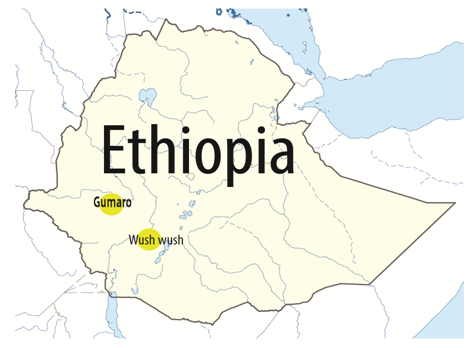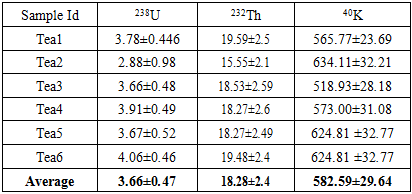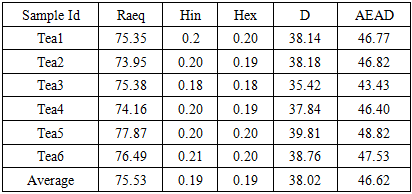-
Paper Information
- Paper Submission
-
Journal Information
- About This Journal
- Editorial Board
- Current Issue
- Archive
- Author Guidelines
- Contact Us
Journal of Nuclear and Particle Physics
p-ISSN: 2167-6895 e-ISSN: 2167-6909
2020; 10(1): 9-12
doi:10.5923/j.jnpp.20201001.02

Investigations of Natural Radioactivity Levels and Assessment of Radiological Hazard of Tea Samples Collected from Local Market in Ethiopia
Tadelech Sisay Mekonnen, Tilahun Tesfaye Deressu
Department of Physics, Addis Ababa University, Addis Ababa, Ethiopia
Correspondence to: Tilahun Tesfaye Deressu, Department of Physics, Addis Ababa University, Addis Ababa, Ethiopia.
| Email: |  |
Copyright © 2020 The Author(s). Published by Scientific & Academic Publishing.
This work is licensed under the Creative Commons Attribution International License (CC BY).
http://creativecommons.org/licenses/by/4.0/

In this study, the activity concentrations of natural (238U, 232Th, 40K) and artificial radionuclides (137Cs) were measured in six different brands of tea samples. The samples have been collected from local market in Ethiopia (Addis Ababa city) and analysis was done by a detection system consisting of High Purity Germanium (HPGe) detector and multichannel analyser. The average activity concentrations of 238U, 232Th and 40K were found to be 3.66±0.47, 18.28±2.4 and 582.59±29.64 Bq/kg respectively. The activity concentration of 40K is increasing faster than the other NORM for Tea. In order to evaluate the radiological hazard of the natural radioactivity, radium equivalent (Raeq), the external hazard index (Hex), internal hazard index (Hin), the total absorbed dose rate (D), and the annual effective dose equivalent (AEDE) have been calculated and compared with the international acceptable values.
Keywords: Natural Radioactivity, Tea sample, Radiological indices, HpGe detector
Cite this paper: Tadelech Sisay Mekonnen, Tilahun Tesfaye Deressu, Investigations of Natural Radioactivity Levels and Assessment of Radiological Hazard of Tea Samples Collected from Local Market in Ethiopia, Journal of Nuclear and Particle Physics, Vol. 10 No. 1, 2020, pp. 9-12. doi: 10.5923/j.jnpp.20201001.02.
Article Outline
1. Introduction
- Radioactivity is part of the physical environment. The sources of the background radiation in the environment are radionuclides of primordial origin (40K, 238U and 232Th); cosmogenic radionuclides (3H, 7Be, 12C, 22Na) and anthropogenic radionuclides (137Cs, 90Sr, 85Kr). These radionuclides exist in the soil, rocks, water and air. Studies indicate that about 87percent of the radiation dose received by humankind is from the natural radiation of primordial and cosmogenic origin, and the remaining is due to anthropogenic radiation [6]. This dose, to the general population, is received from the natural radiation either by external exposure or internal exposure that may occur via complex environmental path ways [4]. Radionuclides such as 40K, 210Po and 226Ra that occur naturally in soil are incorporated metabolically into plants and ultimately find their way into food and water. Artificial radionuclides behave in a similar manner, and worldwide contamination of the food chains by radionclides produced during tests of nuclear weapons in the atmosphere has taken place since the 1960s. In addition to root uptake, deposition on foliar surfaces can occur directly or as a result of dry or wet deposition, in which case contaminants can be absorbed metabolically or, more likely, transferred directly to animals that consume the contaminated foliage [Eisenbud].Tea plants may be subjected to direct and indirect contamination of radionuclides from progenies of 238U and 232Th decay chains or 40K. Radionuclides from fallout can also contaminate tea plants. These radionuclides can be distributed in different parts of the plants according to the chemical characteristics and parameters of the plants and soil [5]. For assessing the effects of radiation exposure due to both natural and artificial radioactivity, part of which dealing with radionuclides of fallout origin. 137Cs and 90Sr is reported by [4]. The aim of this study is to determine natural radioactivity levels (238U, 232Th, 40K) and artificial (137Cs) radioactivity levels in tea samples collected from local market in Ethiopia. The average radium equivalent activity (Raeq), the external hazard index (Hex), the total absorbed dose rate (D), and the annual effective dose equivalent (AEDE) have also been calculated and compared with the results in literature.
2. Materials and Methods
- Six samples of different brands of tea have been collected from the local market in Ethiopia (Addis Ababa city) during the year of the experiment. Ethiopian tea brands are originating from two plantations, namely Wush Wush Tea Plantations and Gumaro tea plantation. The Wush Wush Tea Plantation is located in the Kaffa zone of Sourthern Region (460km South West of Addis Ababa) at 1900m above sea level. The soil there is fertile, good drainage, red brown color, reach in organic matter.THE Gumaro Tea Plantation is located in Illubabor Zone, Oromaya Region, South Western Ethiopia (637 km South West of Addis Ababa) at an altitude of 1718 m. The soil profile is fertile is the same as that of Wush wush plantation, good drainage, red brown color, reach in organic matter.
 All brands collected from the Addis Ababa markets were harvested and processed from the tea farms in Gumaro or Wush wush.. After collecting, the samples were dried in a drying, In order to remove moisture, tea samples oven at 150°C until constant mass was obtained. Then samples were sealed in standardized Marinelli beaker of volume 0.5 littre. Samples were kept for 30 days for secular equilibrium with 226Ra decay products before the measurements. In this study, gamma spectroscopy analysis system was used to determine activity concentrations and radiological effects. The system consisted of a coaxial p-type high-purity germanium detector that was linked to a multichannel analyser consisting of analog-to-digital converter and Gnie 2000 multichannel analyser software of 8192channels. The spectra of all samples were perfectly analysed by using Genie-2000 spectra analysis software to calculate the concentrations of 238U, 232Th and 40K [2]. The spectra were analysed for energies of daughter nuclides 214Pb(295.2keV), 214Pb (351.9keV), 214Bi (609.3keV), 214Bi(1120.2keV), 214Bi (1764.4keV) and [212Pb(238.6keV), 208Tl(583.1keV), 228Ac(911.2keV), 228Ac(968.9keV)] respectively were recorded. The activity concentrations of 40K were determined directly by measurement of the gamma-ray transitions at 1460.8keV.
All brands collected from the Addis Ababa markets were harvested and processed from the tea farms in Gumaro or Wush wush.. After collecting, the samples were dried in a drying, In order to remove moisture, tea samples oven at 150°C until constant mass was obtained. Then samples were sealed in standardized Marinelli beaker of volume 0.5 littre. Samples were kept for 30 days for secular equilibrium with 226Ra decay products before the measurements. In this study, gamma spectroscopy analysis system was used to determine activity concentrations and radiological effects. The system consisted of a coaxial p-type high-purity germanium detector that was linked to a multichannel analyser consisting of analog-to-digital converter and Gnie 2000 multichannel analyser software of 8192channels. The spectra of all samples were perfectly analysed by using Genie-2000 spectra analysis software to calculate the concentrations of 238U, 232Th and 40K [2]. The spectra were analysed for energies of daughter nuclides 214Pb(295.2keV), 214Pb (351.9keV), 214Bi (609.3keV), 214Bi(1120.2keV), 214Bi (1764.4keV) and [212Pb(238.6keV), 208Tl(583.1keV), 228Ac(911.2keV), 228Ac(968.9keV)] respectively were recorded. The activity concentrations of 40K were determined directly by measurement of the gamma-ray transitions at 1460.8keV.2.1. Activity Concentration
- The activity concentration of each radionuclide in the sample was determined by using the net count rates (cps) for the same counting time under the selected photo peaks, weight of the sample, the photo peak efficiency, and the gamma intensity at a specific energy as given by the following equation [1].
 | (1) |
2.2. Radiological Effects
- Since, the distribution of 238U, 232Th and 40K in the environment is not uniform so that with respect to the radiation, the radiological effect of the radioactivity can be measured via absorbed dose(nGy/h), The annual effective dose Equivalent .radium equivalent activity (in Bq/Kg), and external and radiation hazard indices.
2.3. Absorbed Dose (D(nGy/h))
- The assessment of radiological hazard due to exposure of external terrestrial gamma-ray radiation from 226Ra(238U), 232Th and 40K in plant, food, rocks, soils and building materials can also be measured using Absorbed Dose Rate in Air (ADRA) at about 1m above the ground. It is computed based on the following equation 3 [7].
 | (2) |
 stands for activity of U-238in Bq/Kg,
stands for activity of U-238in Bq/Kg,  stands for activity of, 232Th and
stands for activity of, 232Th and  stands for activity of 40K. .. This dose rate indicates the received dose from radiation emitted by rdionuclides in environmental materials [5].
stands for activity of 40K. .. This dose rate indicates the received dose from radiation emitted by rdionuclides in environmental materials [5].2.4. The Annual Effective Dose Equivalent (AEDE)
- The annual effective dose Equivalent (AEDE) was calculated by using equation 4
 | (3) |
2.5. Radium Equivalent Calculation 
- The specific activity of materials containing different amounts of 238U, 232Th and 40K according to [1] was calculated.
 | (4) |
 and
and  are the activity concentrations of 238U, 232Th and 40K in Bq/kg respectively. The permissible maximum value of the radium equivalent activity is 370Bq/kg.
are the activity concentrations of 238U, 232Th and 40K in Bq/kg respectively. The permissible maximum value of the radium equivalent activity is 370Bq/kg.2.6. External  and Internal
and Internal  Hazard Index
Hazard Index
- The natural radioactivity of tea can be estimated using internal and external radiation indices based on the following expressions [7].
 | (5) |
 | (6) |
 and internal index
and internal index  should be each less than unity. Where:
should be each less than unity. Where: 
 and
and  are the activity concentrations in Bq/kg of 238U, 232Th and 40K respectively..
are the activity concentrations in Bq/kg of 238U, 232Th and 40K respectively..3. Results and Discussion
- The results of activity concentrations in the Six samples of different brands of tea have been collected from the local market in Ethiopia (Addis Ababa city) are gives in table 1 for the natural radionuclides of 238U, 232Th and 40K. Radium equivalent activity (Raeq), external hazard index (Hex), internal hazards index (Hin), absorbed dose rates (D), annual effective doses equivalent (AEDE) are given in table 2.
|
|
|
4. Conclusions
- The activity concentrations and the radiological hazard were calculated from measurements made on the six samples. The results of the study led to the following conclusions.The mean activity concentration of 238U, 232Th and 40K were indented with average values of 3.66±0.47Bq/kg, 18.28±2.4 Bq/kg and 582.59±29.64 Bq/kg respectively. Annual effective dose associated with the tea samples have been found to vary from 43.43 µSv/y to 48.82 µSv/y with an average value 46.62 µSv/y respectively Which is less than the effective dose limit 1 mSv. Values of radium equivalent activity in all samples are less than the permissible maximum value of the radium equivalent activity which is 370Bq/kg according to UNSCEAR 2000 report. The obtained mean values of internal and external hazard indices for different tea samples are less than unity. No artificial radionuclide was found in any of the tea samples. Most of the values were less than with other study in the world. So, tea consumption in Ethiopia is non-hazardous for public health..
ACKNOWLEDGEMENTS
- The authors are thankful to the Ethiopian Radiation PRotection Authority for availing their HPGe detectction system for this work. We are also grateful to the Department of Physics, Addis Ababa University for facilitating the the work.
 Abstract
Abstract Reference
Reference Full-Text PDF
Full-Text PDF Full-text HTML
Full-text HTML

